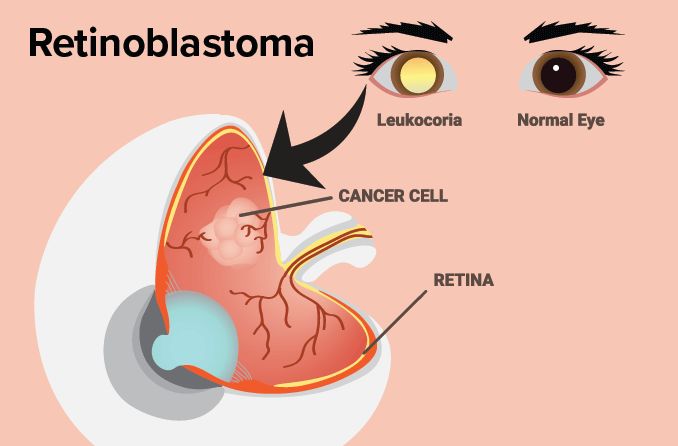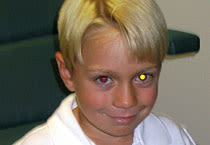Retinoblastoma

What is retinoblastoma?
Retinoblastoma is a rare form of eye cancer that starts in the retina, the layer of tissue which lines the back of the eye. The cancer can develop in one or both eyes and affects infants and young children.
Though the condition is rare, with an estimated 200-300 cases diagnosed per year, the American Cancer Society reports that it is the most common form of eye cancer in children. If not treated promptly, retinoblastoma can spread to other parts of the eye and body, including the spine and brain.
Causes of retinoblastoma
Retinoblastoma ("reh-tin-oh-blas-TOE-muh") occurs when nerve cells in the retina genetically mutate, multiply and spread. When a massive number of these cells form, a cancerous tumor develops in the eye. Once detected, it’s important for retinoblastoma to be treated right away, as it can potentially spread to the brain, spine and other parts of the body.
This condition can be inherited or occur sporadically. Though it is not clear what causes retinoblastoma in sporadic cases, genetic mutations can be passed along from either parent in cases of children with hereditary retinoblastoma.
SEE RELATED: Learn how DNA health testing can detect eye diseases
Retinoblastoma symptoms
Symptoms of retinoblastoma can be difficult to identify since the condition occurs in young children, who are not always able to verbally express what they are experiencing.
Some retinoblastoma symptoms can include the following:
Whiteness in the center of the eye (pupil) that is especially visible when dim light is shone on the area
Redness
Swelling
Eyes looking in two different directions
Whiteness in the center of the eye is one of the key signs of retinoblastoma, and should be reported to an eye doctor immediately — especially if it is accompanied by any other symptoms listed above. Since retinoblastoma can occur in one or both eyes, it is important to take note of whether symptoms appear to occur in either or both eyes.
SEE RELATED: Photos may help detect eye diseases in your children
When to see an eye doctor
Some symptoms of retinoblastoma are broad and difficult to differentiate from other possible eye conditions in your child. However, if your child develops whiteness in the center circle of their eye — often noticeable in dim lights or in photographs that were taken with a flash camera — see an eye doctor immediately. This sign is the most prominent indicator of retinoblastoma.

A family photo helped reveal this little boy's eye disease. (Picture: Megan Webber)
Children who are at risk of developing retinoblastoma due to family history should begin having regular eye exams at a young age. This will allow an eye doctor to monitor them closely for very early signs of the condition.
Although both hereditary and sporadic cases of retinoblastoma typically occur before the age of 6, the condition may occur earlier in children if it is hereditary.
Diagnosing retinoblastoma
The first step in diagnosing retinoblastoma is a preliminary eye exam, in which an eye doctor will assess your child’s symptoms. The full diagnosis, however, will often involve multiple steps, including the following:
An initial eye exam will be performed to determine what is causing any symptoms of retinoblastoma.
Scans and imaging tests, such as an ultrasound, magnetic resonance imaging (MRI) or computed tomography (CT) scan help detect if there has been any progression of the condition.
Additional testing and evaluation may need to be performed by a doctor such as an oncologist, who specifically treats cancer.
SEE RELATED: A guide to children’s vision problems
Treatment
If retinoblastoma is detected early, it is usually treatable through methods such as radiation, chemotherapy, laser therapy or surgery. The treatment types may vary, depending on the size of the tumor and its progress.
Cryotherapy and thermotherapy
Cold treatments (cryotherapy) and heat treatments (thermotherapy) may be used in some cases to kill the cancerous cells of retinoblastoma.
In cryotherapy, liquid nitrogen or another extremely cold substance is used to freeze cancer cells. The process of thermotherapy is similar, only extreme heat is used to kill the cancer cells instead.
Radiation
During radiation, high-energy beams like protons or x-rays are used to target cancer cells. For retinoblastoma treatment, your child may receive one of the following:
Internal radiation, which takes place in or around the tumor
External radiation, which involves a large machine that delivers beams aimed at the area of the tumor
Chemotherapy
Chemotherapy involves sending chemicals through the body to shrink a tumor, and is distributed through either a pill or a blood vessel. In treating retinoblastoma, chemotherapy may be used to shrink the tumor down to a size that would allow another form of therapy or treatment to kill the remaining cancer cells.
Laser therapy
A doctor may perform laser therapy to treat retinoblastoma by aiming a laser at the blood vessels which feed the tumor. These blood vessels are destroyed by the laser, cutting off the tumor’s source for nutrients to grow.
If not treated promptly, retinoblastoma can worsen and/or lead to the cancer spreading in other parts of the body. In these severe cases, the condition can be life threatening.
Surgery
If a tumor has grown or progressed too far for radiation, chemotherapy or other treatments, it may be necessary for the eyeball to be surgically removed through a procedure called an enucleation to prevent the tumor from spreading to the brain or spine.
Once the eyeball is removed, it will be replaced with an artificial implant in the eye socket, and attached to the eye muscles. Over time, the muscles will control the implant as they did the eye, but the implant will not be able to see as the eye did.
The final step in this process is replacing the implant with a custom artificial eye. An artificial eye does not have the ability to see but can be customized to match the healthy eye.
SEE RELATED: Orbital pseudotumor
Preventing retinoblastoma
Regular eye exams are crucial for eye health; they allow your doctor to assess any problems, whether minor or severe, as soon as possible.
Children should have their first comprehensive eye exam at six months of age to make sure eyes and vision are developing properly.
If your child is at risk for developing retinoblastoma due to a family history of the condition, let your doctor know. Your child may require additional monitoring to ensure that any development of retinoblastoma is cared for properly at the first sign.
READ MORE: Eye exams for children: Why they’re important
Page published on Wednesday, January 27, 2021






